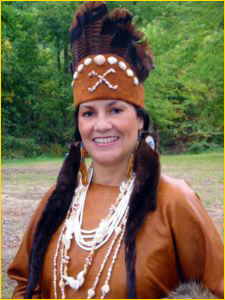The Rappahannocks first met Captain John Smith in December 1607 at their capital town “Topahanocke” on the banks of the river bearing their name. At the time, Smith was a prisoner of Powhatan’s brother, Opechancanough. He took Smith to the Rappahannocks for the people to determine if Smith was the Englishman who, three years earlier, had murdered their chief and kidnapped some of their people.
Smith was found innocent, at least of these crimes. The perpetrator was a tall man. Smith was too short and too fat. Smith returned to the Rappahannock’s homeland in the summer of 1608. He mapped 14 fourteen Rappahannock villages on the north side of the river. The Rappahannock’s territory on the south side of the Rappahannock River was their primary hunting grounds.
English settlement in the Rappahannock River valley began illegally in the 1640s. The Rappahannocks sold their first piece of land to the English in 1651. However, Rappahannock chiefs and councilmen spent more than ten years in county courts trying to get payment for this and other land sales. They never received full payment. By the late 1660s, encroaching settlers and frontier vigilantes forced the Rappahannocks to move, first inland on the north side of the Rappahannock River and later to their ancestral hunting grounds on the south side of the river.
During Bacon’s Rebellion, the Rappahannocks hid with other Tribes in the Dragon Swamp to avoid those English vigilantes who sought to kill all Indians “for that they are all Enemies.” After the rebellion, the Rappahannocks consolidated at one village. In November 1682, the Virginia Council laid out 3,474 acres for the Rappahannock “about the town where they dwelt.” One year later, the Virginia colony forcibly removed the Tribe from their homes and relocated them to Portobago Indian Town. There, the colony used the Tribe as a human shield to protect white Virginians from the New York Iroquois who continued to attack the Virginia frontier and threaten the expansion of English settlement.
In 1705, the Nanzatico Indians, who lived across the Rappahannock River from Portobago Indian Town, were sold into slavery in Antigua. Within a year, the Rappahannocks were, once again, driven from their homes. The Essex County militia removed the Rappahannocks from Portabago Indian town and the land there was patented by English settlers. The Rappahannocks returned to their ancestral homelands downriver, where they continue to live today.
In an effort to solidify their tribal government in order to fight the state for their recognition, the Rappahannocks incorporated in 1921. They were officially recognized as one of the historic tribes of the Commonwealth of Virginia by an act of the General Assembly on March 25, 1983. The Rappahannocks initiated plans to build a cultural center and museum. In 1995, they began construction of the cultural center project and completed two phases by 1997. Phase three, a planned museum, is in the planning stages.

In 1998, the Rappahannocks elected the first woman Chief, G. Anne Richardson, to lead a Tribe in Virginia since the 1700s. As a fourth generation chief in her family, she brings to her position a long legacy of community leadership and service among her people. Also in 1998, the Tribe purchased 119.5 acres to establish a land trust, retreat center, and housing development. The Tribe built their first model home and sold it to a tribal member in 2001. Plans are underway for the retreat center. In 1996, the Rappahannocks reactivated their work on federal acknowledgement, which had originally began in 1921 when their Chief George Nelson petitioned the federal Congress to recognize Rappahannock civil and sovereign rights. The Rappahannocks are currently engaged in a number of projects ranging from cultural and educational to social and economic development programs, all geared to strengthen and sustain their community.
The Rappahannocks host their traditional Harvest Festival and Powwow annually on the second Saturday in October at their Cultural Center in Indian Neck, Virginia. They have a traditional dance group called the Rappahannock Native American Dancers and a Drum group called the Maskapow Drum Group. Both of these groups perform locally and abroad in their efforts to educate the public on Rappahannock history and tradition.
The mission of the Tribe is to preserve Rappahannock culture, social structures, and political structures while educating the public on the rich contributions that Rappahannocks have made and continue to make to Virginia and the Nation. State recognized: March 25, 1983
Chief G. Anne Richardson was sworn in as the Chief of the Rappahannock Tribe in 1998. She is the first female Indian chief in Virginia since Cockcoeske became ruler of the Powhatan Confederacy in the mid-1600’s. She succeeds her father, Chief Captain Chawanta Nelson of 34 years as chief.